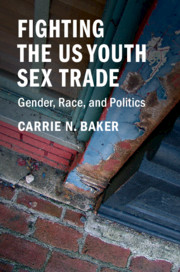Book contents
- Fighting the US Youth Sex Trade
- Fighting the US Youth Sex Trade
- Copyright page
- Contents
- Figures
- Acknowledgments
- Abbreviations
- Introduction
- 1 “My God! If Only I Could Get Out of Here”: Roots of Contemporary Activism Against the US Youth Sex Trade
- 2 “Teeny Hookers” and the “Chicken Hawk Trade”
- 3 Survivor Activism and Global Connections: The US Campaign against Commercial Sexual Exploitation of Children in the 1990s
- 4 “Our Daughters” in Danger: Leveraging the Anti-Trafficking Framework in the early 2000s
- 5 To Rescue or Empower: Building a Collaborative Adversarial Movement
- 6 “Locked in Like a Dog in a Kennel”: Expanding Tactics, Challenging Systems
- 7 “Quick Fixes and Good Versus Evil Responses”: Criticisms of the Movement
- Conclusion: Ending the US Youth Sex Trade?
- Select Bibliography
- Index
5 - To Rescue or Empower: Building a Collaborative Adversarial Movement
Published online by Cambridge University Press: 14 September 2018
- Fighting the US Youth Sex Trade
- Fighting the US Youth Sex Trade
- Copyright page
- Contents
- Figures
- Acknowledgments
- Abbreviations
- Introduction
- 1 “My God! If Only I Could Get Out of Here”: Roots of Contemporary Activism Against the US Youth Sex Trade
- 2 “Teeny Hookers” and the “Chicken Hawk Trade”
- 3 Survivor Activism and Global Connections: The US Campaign against Commercial Sexual Exploitation of Children in the 1990s
- 4 “Our Daughters” in Danger: Leveraging the Anti-Trafficking Framework in the early 2000s
- 5 To Rescue or Empower: Building a Collaborative Adversarial Movement
- 6 “Locked in Like a Dog in a Kennel”: Expanding Tactics, Challenging Systems
- 7 “Quick Fixes and Good Versus Evil Responses”: Criticisms of the Movement
- Conclusion: Ending the US Youth Sex Trade?
- Select Bibliography
- Index
Summary
- Type
- Chapter
- Information
- Fighting the US Youth Sex TradeGender, Race, and Politics, pp. 120 - 160Publisher: Cambridge University PressPrint publication year: 2018

